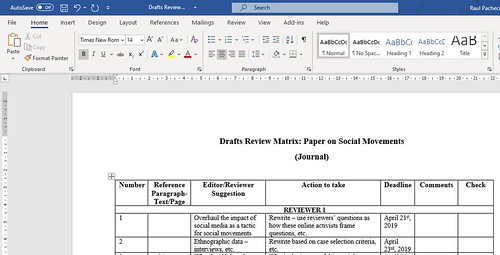On the full-fledged process of responding to a Revise-And-Resubmit (R&R): I have written pieces that tackle specific components of the process, but I hadn’t actually written a thread or a blog post showcasing how all my blog posts fit with one another. I teach this process when I give workshops. So I figured I could post it here on my blog, based on a Twitter thread I created for this purpose.
So here’s what I do (now), and let me share a lesson from my past lives:
DO NOT SIT ON R&Rs.
I know, they’re painful and scary and sometimes we don’t know if our paper will get rejected in the end. But remember, an R&R means an OPPORTUNITY to get your paper published.
Sitting on R&Rs, leaving them for later, and not prioritizing them has gotten me fewer publications. I know this for a fact. I am not ashamed of admitting that I have sometimes felt that I will not be capable of responding to multiple (often conflicting) comments.
HOWEVER…
Sustained, frequent advice from professors who are senior to me (though I am senior myself now too) is always the same and on-point:
The goal is the R&R.
You’re not getting a desk rejection. Take that as a bit of good news!
You are getting your work read, reviewed carefully, thought about, responded to. This is a win. Take it as such.
What do I do now (and have been doing for the past few years, with success) is as follows:
1. When I get the R&R (the “decision letter”), I make sure to calm down, because I am always afraid I’m going to get nasty comments. These have been (luckily) very rarely present in my latest submissions. Some people ask dear friends or collaborators to read the comments and deliver a kinder, gentler critique. I think this is great to soften the blow, but in the end, we are going to have to read the Letter of Response from Editors, so we might as well soldier on.
(I ask my Mom)
My Mom has a PhD in political science, is a full professor, and has been a Dean of Social Sciences, and she loves me, so it’s easier for her to see the good comments in the reviewers’ responses and just tell me “the tone on X comment might grate you but it’s a good one”.
2. Once I read the Editor’s Decision Letter, which include the comments, I pay a lot of attention to what the editor is telling me in the letter. Which reviewers’ comments do they recommend I pay particular attention to? In my experience (and as an Editor, I do this), editors will chart you a path forward: “we believe this paper holds promise, we suggest you might want to go down this path. Alternatively, there’s this other path. Or this other one”
Editors have been incredible generous to me.
3. Here is where all my processes articulate with one another:
Ok, so now you have mapped out everything reviewers and editors have suggested. You have charted a response route. It’s time to use my post on Writing a Response-to-Reviewers-And-Editors. https://t.co/7D4YYpaPid
Some people have sent my DRM directly to editors. I know this.
— Dr Raul Pacheco-Vega (@raulpacheco) February 13, 2021
Most editorial teams will already have a process for how they want the response to look like (redlined version, clean version, point-by-point letter). Some may accept my DRM as is, but I do recommend writing the letter.
4. You probably are thinking “but how I do I plan the R&R” – well, yes, I do have a blog post for that and here it is.
Backcasting allows you (me) to think which days you are going to be working on the R&R and in which pieces. I drop those deadlines into my Everything Notebook, as everyone might realize I do. https://t.co/9O6tG2AHP7
Doing this helps me chart my activities moving forward.
— Dr Raul Pacheco-Vega (@raulpacheco) February 13, 2021
After all is said and done, and you resend the R&R revision, you probably want to take a couple of days off, and reward yourself in some way.
Hope this articulation of my blog posts and my processes are helpful to those of you in the throes of R&R revisions!



0 Responses
Stay in touch with the conversation, subscribe to the RSS feed for comments on this post.